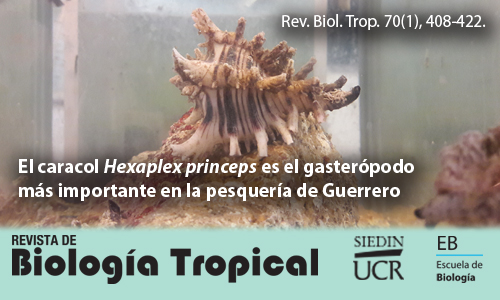Abstract
Reproduction and recommended fishing limitations for the marine snail Hexaplex princeps (Neogastropoda: Muricidae) in Guerrero, Mexico. Introduction: The snail Hexaplex princeps is the most important gastropod in the fishery of Guerrero, but capture is not legally regulated for lack of enough studies about its reproduction, growth and other fishing aspects. Objective: To assess fishery data for H. princeps in Guerrero. Methods: From October 2016 to December 2017, we analyzed histological samples of the gonads from 6 to 13 individuals per month. We also collected data on pre-reproductive organisms captured in Costa Chica (2013 and 2014), Costa Grande (2017) and Acapulco (2019 and 2020). Results: Both sexes have five stages of gonadal development; most reproductive activity was from December to July, related to sea surface temperatures of 26 to 28 °C. The LCM in females was 94.1 mm (males: 86.1 mm). There was a high percentage of juvenile organisms in the catches (88.6 %). Conclusions: To let these snails reproduce at least once, we recommend a fishing ban from December to July, and that the minimum size of commercial capture be set at 94.1 mm.
##plugins.facebook.comentarios##

This work is licensed under a Creative Commons Attribution 4.0 International License.
Copyright (c) 2022 Revista de Biología Tropical







